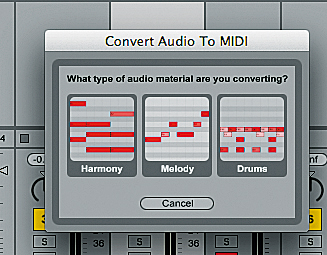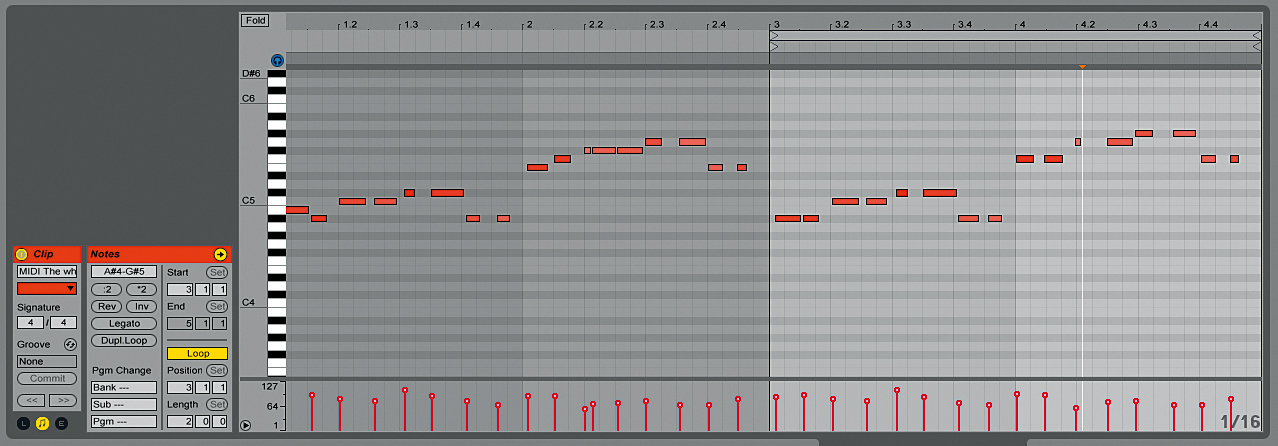Hands-on with Ableton Live 9: Audio to MIDI
We get to grips with one of Live 9's best new features

Our look at the new features of Ableton Live 9 continues as we get hands-on with one of the DAW's coolest new tricks - Audio-to-MIDI.
Computer Music sat down with the public beta version of Live 9 earlier this year, and what you read here are the things they learned from several days of exploring every nook and cranny of this major update.
Audio to MIDI
One of the trickiest things for non-classically trained musicians to do well is to recreate musical parts by ear. How many hours have been wasted by bedroom producers around the world nervously tapping their MIDI keyboards to figure out a musical riff from another track or part?
Even with skilled ears, it can be difficult, particularly when you're playing a totally different sound to the one you're copying.

Many lateral-thinking producers resort to using software like Auto-Tune to analyse the riff for them, then export the MIDI part for use with their own synths, but this is a labour-intensive process that drags you away from the spontaneous flow of music creation. And, unless you have Melodyne or similar, it's of no use when dealing with chords.
Live 9 introduces Audio To MIDI. More specifically, it offers three analysis and conversion modes, enabling you to convert Melody, Harmony or Rhythm to MIDI. This is not the simple beat-slicing of old - this function analyses your audio, picks out the notes, then creates a MIDI track, complete with a basic synth patch. That last point is important, as it means you can instantly hear what Live has come up with and start tweaking notes as required.
There are two carefully tailored algorithms for dealing with monophonic (Melody) and polyphonic (Harmony) source material, and believe us when we say that they're a stunning success.
Want all the hottest music and gear news, reviews, deals, features and more, direct to your inbox? Sign up here.
It's not often that a new DAW feature genuinely revolutionises workflow, but quite simply, this one has the potential to transform what is and is not creatively within the reach and limits of the Live user.
Drums to MIDI
Just as clever and useful is the third option, Drums To MIDI. This algorithm analyses a drum loop and turns it into a MIDI clip, complete with drum kit for instant auditioning, making educated (and spookily accurate) guesses about the types of drums being played (you get a MIDI note each for kicks, snares and hats, and an 'extra' one for whenever Live is unsure of the sound type).
This is something that could be achieved pre-Live 9 using beat-slicing and a lot of virtual elbow-grease and perseverance, but the convenience of being able to just analyse and recreate a loop almost instantly is just staggering. Gone are the days of dragging all your slice-triggering MIDI notes down to just a few keys at the bottom of the piano roll and either looking for the cleanest hits or copying that MIDI part to another drum channel.
We must stress this point: all three of these algorithms are just one click away. In fact, if you add an audio file to a MIDI channel that has an instrument on it, Live will helpfully ask you which of the three you want to convert the audio to: Melody, Harmony or Drums.
We honestly think Audio To MIDI will prove incentive enough on its own for many users to upgrade, and it's likely to encourage a great number of green-eyed aficionados of other DAWs to either take the Ableton plunge or ignore calls from their Live-using friends for as long as it takes their sequencing weapon of choice to add something similar.
Mouthing off
When we first heard about Audio to MIDI, we were intrigued, but until we tried it, we didn't realise the full implications. Yes, it means you can deconstruct other people's tracks for remixing and adapt your own loops, but anybody who's ever wished they could have their computer turn the beat or melody in their head into something on the screen should prepare to see their dream become reality.
Live 9's algorithms don't just work on sampled beats; they work on beat-boxing and singing, whistling or humming - in fact, anything with defined notes.

We tried a variety of techniques, including humming into our phone, and apart from having to EQ some of the mess out of the recording and compress it to ensure the quieter sounds were audible, it worked.
This really is a giant leap forwards in terms of functionality, and it's particularly useful for the army of users out there who can hum the riff they want but sometimes struggle to play it in while keeping the timing and/or notes correct.
Tomorrow: MIDI editing and automation
We investigate Live's new automation possibilities


Computer Music magazine is the world’s best selling publication dedicated solely to making great music with your Mac or PC computer. Each issue it brings its lucky readers the best in cutting-edge tutorials, need-to-know, expert software reviews and even all the tools you actually need to make great music today, courtesy of our legendary CM Plugin Suite.
